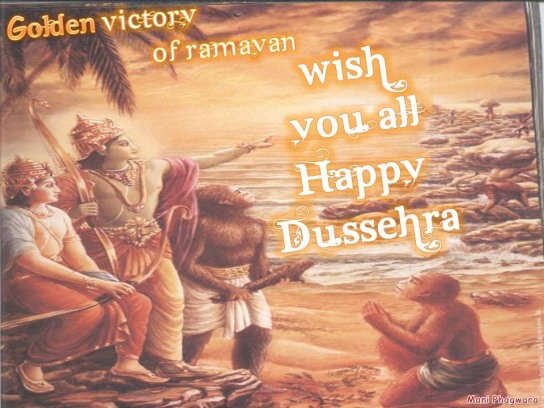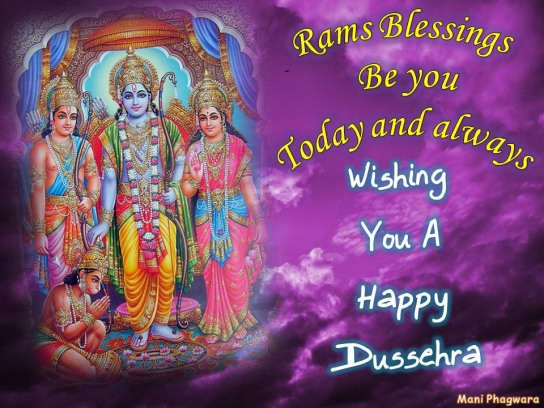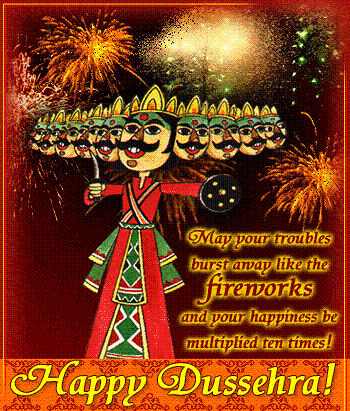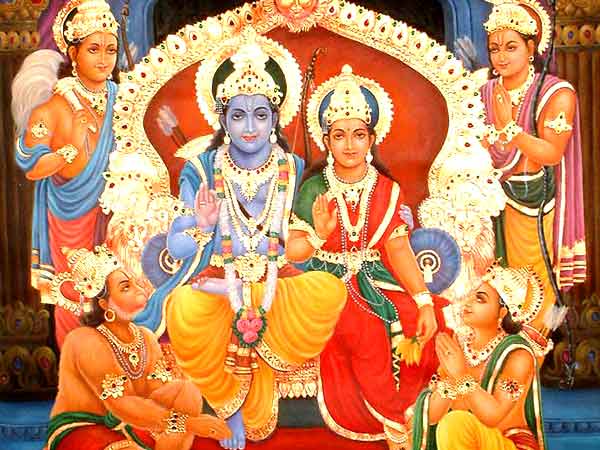Dussehra
The tenth day of Navaratri marks the end of fasting and is celebrated as Dussehra.This festival is celebrated by burning effigies of Ravana, Kumbarkaran and Megnath.




Legends Of Dusshera
Dussehra is mainly associated with the story of Rama based on Ramayana, one of the two great Indian epics. Set around 1000 BCE in India, this epic attempts to establish the social ideals and explains the depth of human relationships. Lord Rama was the protagonist of the epic, while his wife Sita was its female lead. He has been idolized as the ideal son, husband and king, while she is the epitome of womanhood. Lord Rama was the eldest son of Dashratha, the king of Ayodhya and was beloved of all, because of his genial ways. The king decided to hand over his throne to him and retire.
Contrary to her husband's decision, Lord Rama's stepmother (Kaikayi) wanted her own son Bharata to be the king and forced Dashratha to banish Rama from Ayodhya, the kingdom and give him fourteen years of exile. Rama gladly accepted the stepmother's wishes and left the palace and the kingdom with his wife Sita, and brother Lakshmana. The grief-stricken father soon died. When Bharata, who was on a visit to his maternal grandfather, came back and came to know what his mother had done, he immediately set out to being his brother back from the forest.
Rama was glad to welcome his brother Bharata, but he refused to go back to the kingdom before the completion of his exile. Rama had another loss at hand, as the demon-king Ravana, abducted his wife Sita and took her away to his kingdom. This became the reason behind the long search and the various events that followed, which led to the destruction of Ravana by the hands of Lord Rama, with the help of the monkey army he had befriended on his way to Lanka. Dussehra is the day, when Rama killed Ravana and won back his wife. Hence, Dusshera is also called Vijayadashmi.
Dussehra celebrates the victory of good (Rama) over the evil (Ravana). This is the reason why effigies of Ravana, Meghnatha and Kumbhkarna are burnt on Dusshera, all over northern India. Apart from this, Vijayadashmi also symbolizes the victory of Goddess Durga over Mahishasura, the demon who held the earth and the swarglok (heaven) with his tyranny and invincible power. Hence, it can be said that two legends are connected to the celebration of Dussehra in India.




The tenth day of Navaratri marks the end of fasting and is celebrated as Dussehra.This festival is celebrated by burning effigies of Ravana, Kumbarkaran and Megnath.




Legends Of Dusshera
Dussehra is mainly associated with the story of Rama based on Ramayana, one of the two great Indian epics. Set around 1000 BCE in India, this epic attempts to establish the social ideals and explains the depth of human relationships. Lord Rama was the protagonist of the epic, while his wife Sita was its female lead. He has been idolized as the ideal son, husband and king, while she is the epitome of womanhood. Lord Rama was the eldest son of Dashratha, the king of Ayodhya and was beloved of all, because of his genial ways. The king decided to hand over his throne to him and retire.
Contrary to her husband's decision, Lord Rama's stepmother (Kaikayi) wanted her own son Bharata to be the king and forced Dashratha to banish Rama from Ayodhya, the kingdom and give him fourteen years of exile. Rama gladly accepted the stepmother's wishes and left the palace and the kingdom with his wife Sita, and brother Lakshmana. The grief-stricken father soon died. When Bharata, who was on a visit to his maternal grandfather, came back and came to know what his mother had done, he immediately set out to being his brother back from the forest.
Rama was glad to welcome his brother Bharata, but he refused to go back to the kingdom before the completion of his exile. Rama had another loss at hand, as the demon-king Ravana, abducted his wife Sita and took her away to his kingdom. This became the reason behind the long search and the various events that followed, which led to the destruction of Ravana by the hands of Lord Rama, with the help of the monkey army he had befriended on his way to Lanka. Dussehra is the day, when Rama killed Ravana and won back his wife. Hence, Dusshera is also called Vijayadashmi.
Dussehra celebrates the victory of good (Rama) over the evil (Ravana). This is the reason why effigies of Ravana, Meghnatha and Kumbhkarna are burnt on Dusshera, all over northern India. Apart from this, Vijayadashmi also symbolizes the victory of Goddess Durga over Mahishasura, the demon who held the earth and the swarglok (heaven) with his tyranny and invincible power. Hence, it can be said that two legends are connected to the celebration of Dussehra in India.




No comments:
Post a Comment